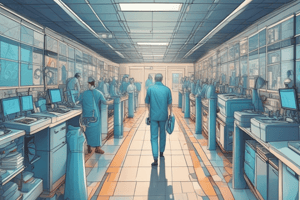Podcast
Questions and Answers
What does post-Fordism primarily emphasize in production methods?
What does post-Fordism primarily emphasize in production methods?
- Highly hierarchical structures
- Single product production for mass markets
- Mass production with fixed machines
- Lean production and flexible approaches (correct)
Which dimension did Lawrence and Lorsch identify when analyzing internal structures of firms?
Which dimension did Lawrence and Lorsch identify when analyzing internal structures of firms?
- The level of employee satisfaction in departments
- The total revenue generated per department
- The training programs offered in each department
- The differentiation of functional departments (correct)
What change in contractual relationships is associated with the transition from traditional to modern production methods?
What change in contractual relationships is associated with the transition from traditional to modern production methods?
- All employees receive equal pay regardless of performance
- Job security is guaranteed for all employees
- Contracts are generally union-negotiated for all workers
- Shift towards individual pay based on performance (correct)
In the context of the internal variables examined by Lawrence and Lorsch, what aspect had a complex relationship with external variables?
In the context of the internal variables examined by Lawrence and Lorsch, what aspect had a complex relationship with external variables?
Which type of organizational structure is characterized by subcontracting and decentralized operations?
Which type of organizational structure is characterized by subcontracting and decentralized operations?
What characterizes the modern adaptation of organizational structures compared to traditional bureaucratic forms?
What characterizes the modern adaptation of organizational structures compared to traditional bureaucratic forms?
What is one significant shift in the organizational approach due to offshoring and outsourcing?
What is one significant shift in the organizational approach due to offshoring and outsourcing?
What describes the concept of the 'Boundaryless Organization' as presented by Ashkenas et al.?
What describes the concept of the 'Boundaryless Organization' as presented by Ashkenas et al.?
What is a common feature of divisionalized structures in modern organizations?
What is a common feature of divisionalized structures in modern organizations?
How have reward systems in flatter organizations changed compared to traditional bureaucratic organizations?
How have reward systems in flatter organizations changed compared to traditional bureaucratic organizations?
Flashcards
Internal Market
Internal Market
A market-driven system of transactions within an organization, often involving increased autonomy for certain parts.
Bureaucratic Organization
Bureaucratic Organization
A traditional organizational structure characterized by strict hierarchies and procedures.
Adaptive Organization
Adaptive Organization
An organization capable of adjusting to changes in the marketplace and its environment.
Flatter Structure
Flatter Structure
Signup and view all the flashcards
Boundaryless Organization
Boundaryless Organization
Signup and view all the flashcards
Post-Fordism
Post-Fordism
Signup and view all the flashcards
Woodward's theory
Woodward's theory
Signup and view all the flashcards
Lawrence and Lorsch (1967) study
Lawrence and Lorsch (1967) study
Signup and view all the flashcards
Organizational differentiation
Organizational differentiation
Signup and view all the flashcards
Organizational Integration
Organizational Integration
Signup and view all the flashcards
Study Notes
Organizations: Theory and Practice
- Individuals and groups function within larger organizational frameworks.
- Organizational studies are crucial for understanding their complexities, relationships with other groups, and their external environment.
- Organizational analysis considers systemic effectiveness and control. How is control maintained within the organization itself?
- Parkinson's Law describes how work expands to fill available time.
- Organizational size and complexity are common experiences.
- Individuals often identify with smaller work groups rather than the organization as a whole (mystical force).
- Postmodernism criticizes traditional, "rational" approaches to organizational studies.
- It rejects objective positivism and scientific knowledge accumulation.
- Postmodernism values diversity, symbolism, and reinterpretation of existing systems.
Organizational Structure
- Max Weber's studies of organizations form a basis for later research.
- Weber identified three main authority types: charismatic (based on individual personality); traditional (based on custom and precedent); rational-legal (hierarchy and rules).
- The rational-legal model of organization structure is bureaucratic. It describes a structured organization based on roles and procedures that transcend individual personnel.
- Amitai Etzioni also contributed to studying organization structure by defining three main organizational types: coercive, utilitarian, and normative.
Organizational Approaches
- Systems approach: Organizations are complex, interconnected systems influenced by their environment. Relationships between the organization's parts and its external environment are essential.
- Contingency approach: This approach emphasizes that there's no one best way to organize; different contexts require different structures. Internal and external factors influence organizational design. Focus on flexibility and adaptability.
- Sociotechnical system: Combines technological and social systems; interpersonal relationships affect productivity, and vice versa. The interplay of technology and organization, and the relationships between them, are central.
- Human relations: Focuses on employee needs and psychological influences on behavior within an organization. Mayo, Maslow, McGregor, Herzberg, and Argyris were influential in this perspective. Interactions, motivations, and behaviour in organizations are important.
- Open system: Organizations interact with their environment; they import resources & export products/services. This interaction is part of the organization's survival.
- Organizational design needs to take into consideration how variables in the environment impact it specifically.
- Technology and organizational design are strongly linked. Organizational forms and their effectiveness are heavily influenced by technological change.
Organizational Culture
- Organizational culture is a crucial aspect of how an organization functions and is sometimes seen as a 'glue' for companies.
- Organizational objectives and employee values matter. Employees often exhibit behaviours and organizational roles as a result.
Studying That Suits You
Use AI to generate personalized quizzes and flashcards to suit your learning preferences.




